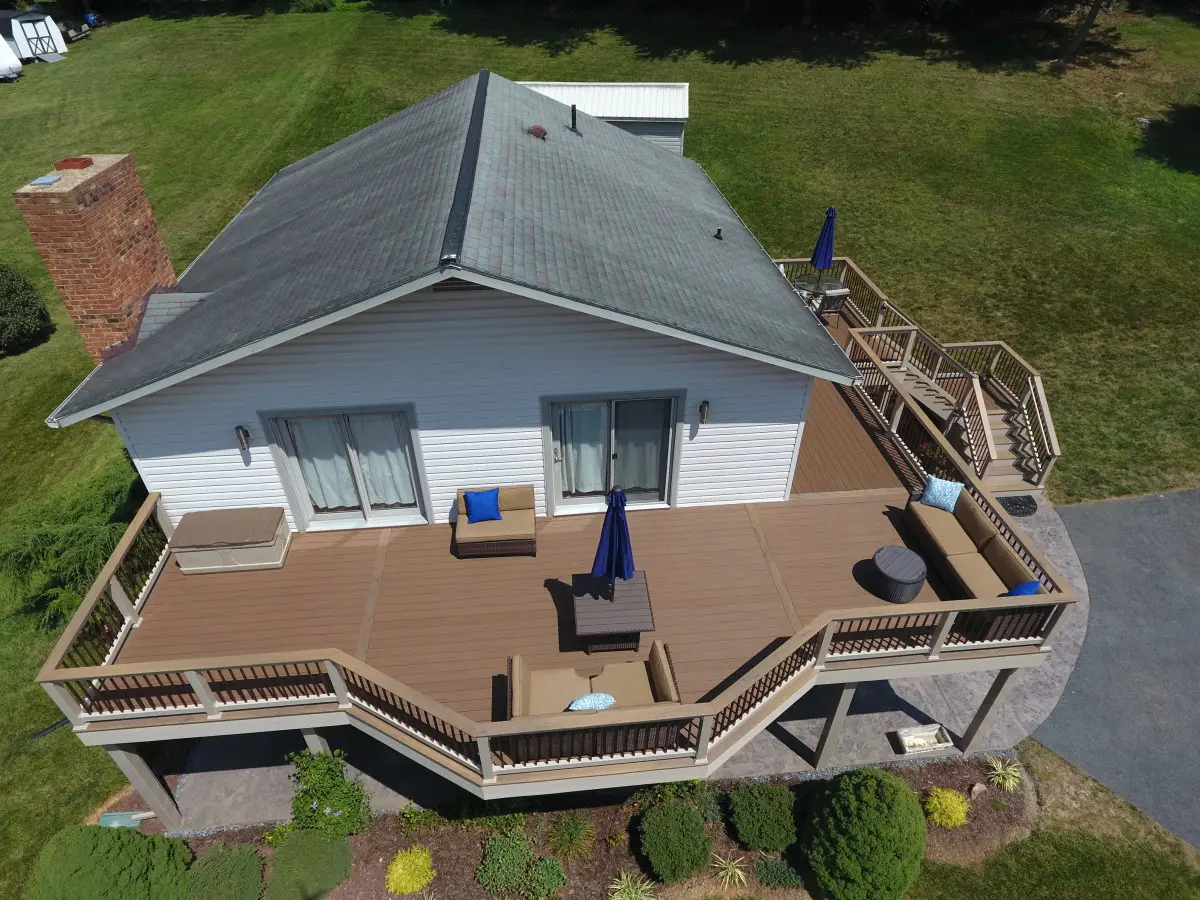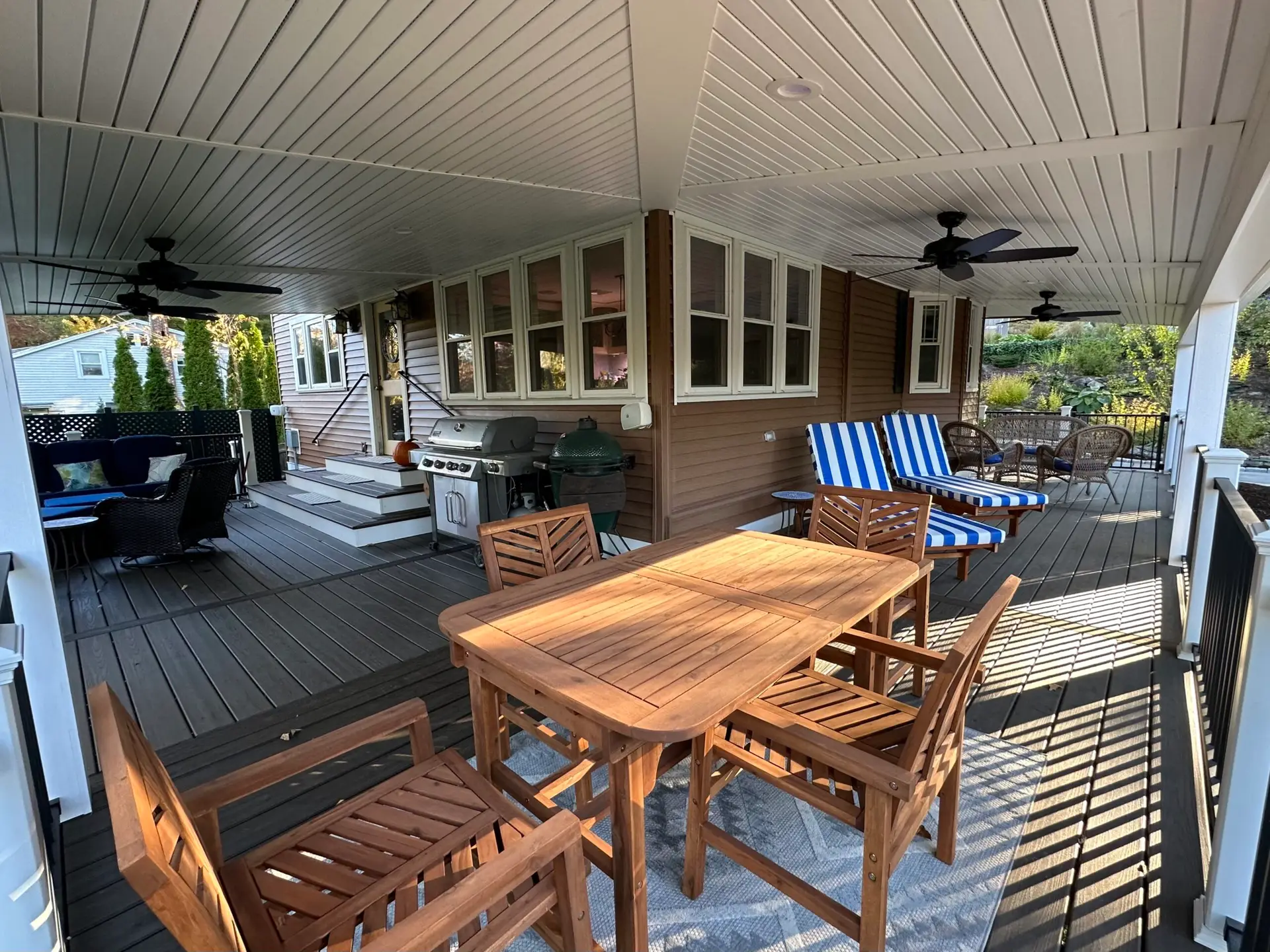Setting the Stage for Your Outdoor Sanctuary
Crafting an inviting and functional deck space is akin to painting a masterpiece where practicality meets aesthetics. The ideal deck layout serves as a harmonious extension of your home, elevating your outdoor living experience. Whether it’s a tranquil nook for savoring your morning brew or an expansive platform for hosting gatherings, the essence of thoughtful design is paramount.
Understanding Your Space
Before diving into design options, take a good look at your available space. Consider the shape of your yard, the direction of sunlight, and any views you want to capture or obscure for privacy. These factors will influence the size, shape, and orientation of your deck.
- Sunset Views and Privacy
- If your backyard faces west and offers beautiful sunset views, consider orienting your deck to take advantage of this. Position seating areas or a dining space to face west, allowing you to enjoy the evening glow.
- To maintain privacy, strategically place taller plants, trellises, or privacy screens on the side of the deck facing neighboring properties or busy streets.
- Morning Sun and Shade
- If your deck receives intense morning sun, think about incorporating a pergola, awning, or retractable shade to provide relief during those hours.
- Consider planting deciduous trees or installing lattice panels to create dappled shade without completely blocking sunlight.

- Yard Shape and Deck Layout
- For a narrow yard, a linear deck along the length of the house may be the best fit. This maximizes usable space while leaving room for landscaping on the sides.
- In a spacious yard, explore multi-level decks or wraparound designs. These layouts can create distinct zones for cooking, lounging, and gardening.
- Views and Focal Points
- If you have a stunning garden, a water feature, or distant hills, position your deck to showcase these views. Consider a corner seating area or a raised platform for better sightlines.
- Frame the views with well-placed railings or low planters to draw the eye outward.
- Deck Shape and Flow
- Irregularly shaped yards can inspire unique deck layouts. Curved decks, octagonal platforms, or decks with diagonal corners can add visual interest.
- Ensure smooth flow by connecting the deck to existing pathways, doors, or other outdoor spaces seamlessly.
- Zoning for Activities
- Divide your deck into functional zones based on activities. For example:
- A cooking area with a grill and counter space.
- A dining area with a table and chairs.
- A lounging area with comfortable seating.
- Arrange these zones to optimize traffic flow and create a cohesive layout.
- Divide your deck into functional zones based on activities. For example:
Deck Design Principles
A well-designed deck should balance form and function. It should be an extension of your indoor living space, providing a seamless transition to the outdoors. Prioritize flow and accessibility, ensuring there’s enough room to move comfortably and that entry and exit points are clear and convenient.
Let’s explore some examples of how to apply deck design principles to create a functional and visually appealing outdoor space:
- Seamless Transition with Sliding Glass Doors:
- Consider installing sliding glass doors that open directly onto the deck. This creates a seamless flow between indoor and outdoor spaces, allowing easy access for entertaining or relaxing.
- Multi-Level Deck for Different Activities:
- Design a multi-level deck with distinct zones. For example:
- Upper level: Dining area with a table and chairs.
- Middle level: Lounge space with comfortable seating.
- Lower level: Built-in fire pit or hot tub.
- Each level serves a specific purpose while maintaining a cohesive design.

- Design a multi-level deck with distinct zones. For example:
- Built-In Benches and Planters:
- Incorporate built-in benches along the perimeter of the deck. These provide extra seating without cluttering the space.
- Integrate planters into the railing design or as standalone features. They add greenery and define the edges of the deck.
- Clear Pathways and Traffic Flow:
- Ensure there’s enough space for people to move comfortably around the deck. Avoid overcrowding with furniture or unnecessary obstacles.
- Designate clear pathways from the house to different areas of the deck, especially near entry points.
- Strategic Placement of Stairs and Railings:
- Position stairs near the main entry points to facilitate movement between indoor and outdoor spaces.
- Choose railings that enhance safety without obstructing views. Glass panels or cable railings are sleek options.
- Outdoor Kitchen Integration:
- If you love cooking outdoors, design a deck area for an outdoor kitchen. Include a grill, countertop, and storage space.
- Plan the kitchen layout to ensure easy access to ingredients, utensils, and seating.
- Lighting for Ambiance and Safety:
- Install deck lighting to create ambiance during evenings. Consider string lights, recessed fixtures, or solar-powered path lights.
- Illuminate stairs and pathways for safety, especially if you’ll be using the deck after dark.
- Material Selection for Durability and Style:
- Choose decking materials that withstand weather conditions and require minimal maintenance. Composite decking or tropical hardwoods are excellent options.
- Match the deck color and texture to your home’s exterior for a cohesive look.
- Furniture Arrangement and Focal Points:
- Arrange furniture to maximize views and comfort. Position seating to face scenic areas or focal points like a garden or water feature.
- Consider adding a pergola or canopy for shade and visual interest.
- Personalize with Outdoor Decor:
- Add personal touches like outdoor rugs, throw pillows, and potted plants. These elements make the deck feel inviting and reflect your style.
- Incorporate outdoor artwork or sculptures as focal points.
Choosing a Deck Style
The style of your deck should reflect the architecture of your home and your personal taste. From a simple platform deck to an elaborate multi-level structure, there are numerous styles to choose from. Consider how each style will fit with the contours of your land and the layout of your home.
When selecting a deck style, it’s important to ensure that it reflects the architectural style of your home and suits your personal preferences. Here are some popular deck styles to consider:
- Platform Deck: Ideal for level areas, this style can be built on the ground or slightly elevated, offering a minimalist look that complements modern homes.

- Raised Deck: Perfect for homes with above-ground first floors, such as split-level homes, providing a smooth transition from the indoors to the outdoors.
- Multi-Level Deck: Great for sloped land or multi-story homes, this style creates separate areas for dining, lounging, and other activities, each on a different level.
- Freestanding Deck: A versatile option that doesn’t need to be attached to the house, allowing it to be placed anywhere in the yard to capture the best views or sunlight.
- Wraparound Deck: Encircling part or all of your home, this style offers multiple access points and can be shaded for comfort, similar to a traditional wraparound porch.

- Covered Deck or Porch: Includes a roof structure to protect against the elements, allowing for outdoor enjoyment regardless of weather conditions.
- Rooftop Deck: An excellent option for urban homes or buildings without yards, providing a private outdoor escape with potential panoramic views.

- Pool Deck: Designed around a pool to provide easy access and a place to lounge, with materials chosen for water resistance and safety.
Each deck style offers unique benefits and can be tailored to fit your specific needs and landscape. Consider working with a professional designer to ensure that your new deck is a perfect addition to your home.
Planning for Deck Activities
Think about how you plan to use your deck. Will it be a quiet retreat for reading and relaxation, a dining area for al fresco meals, or a lively entertainment space? Designate specific areas for each activity and consider the furniture and features you’ll need to accommodate them.
Incorporating Features
Incorporate built-in features like benches, planters, or even a fire pit to add functionality and character to your deck. These features can define different areas of your deck and provide convenient seating and greenery without taking up additional space.
Selecting Materials
Choose materials that will withstand the elements and fit your lifestyle. Wood offers a natural look but requires more maintenance, while composite materials offer durability with less upkeep. Consider the long-term costs and benefits of each option.
Wood Deck


Railing and Safety
Your deck’s railing is not just a safety feature; it’s also an important design element. Choose a railing that complements your deck’s style and provides the necessary safety without obstructing your view.

#image_title
Lighting and Accessories
Proper lighting can transform your deck into an inviting space after dark. Consider a mix of ambient, task, and accent lighting to create the right mood and ensure safety. Add accessories like outdoor rugs, cushions, and decorative elements to personalize your space.


#image_title
Working with Professionals
For a deck that truly meets your needs and stands the test of time, consider working with a professional deck designer or architect. They can help you navigate the myriad of choices and ensure that your deck is built to last.
Summing It Up
Designing the perfect deck layout requires careful consideration of your needs, space, and style. With these tips and tricks, you’re well on your way to creating a deck that you’ll enjoy for years to come.




